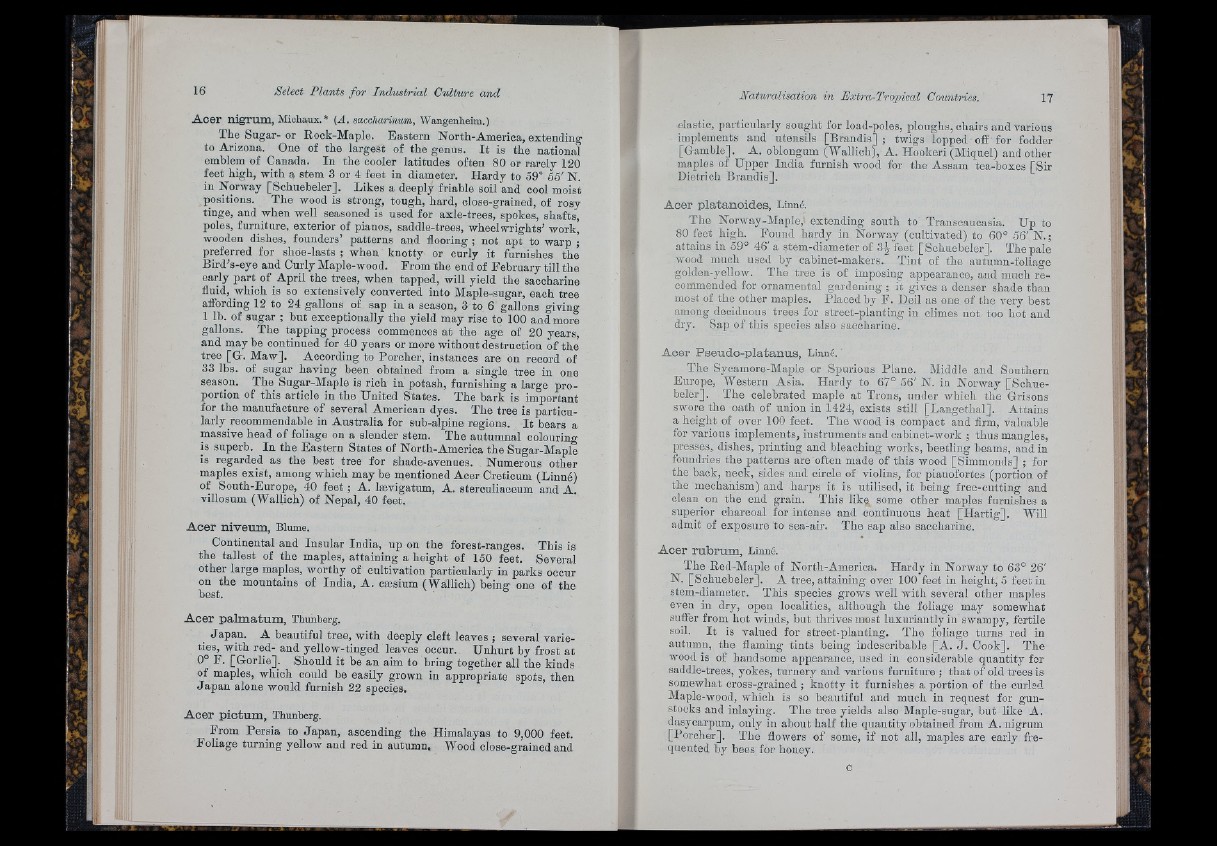
A c e r n ig rum , Michaux.* [A. saccharinum, Wangenheim.)
The Sugar- or Eook-Maple. Eastern North-America, extending
to Arizona. One of the largest of the genus. I t is the national
emblem of Canada. In the cooler latitudes often 80 or rarely 120
feet high, with a stem 3 or 4 feet in diameter. Hardy to 59° 55' N.
in Norway [Schnebeler]. Likes a deeply friable soil and cool moist
positions. The wood is strong, tough, hard, close-grained, of rosy
tinge, and when well seasoned is used for axle-trees, spokes, shafts,
poles, furniture, exterior of pianos, saddle-trees, wheelwrights’ work,
wooden dishes, founders’ patterns and flooring ; not apt to warp ;
jreferred for shoe-lasts ; when knotty or curly it furnishes the
Bird’s-eye and Curly Maple-wood. From the end of February till the
early part of April the trees, when tapped, will yield the saccharine
fluid, which is so extensively converted into Maple-sugar, each tree
affording 12 to 24 gallons of sap in a season, 3 to 6 gallons giving
1 lb. of sugar ; but exceptionally the yield may rise to 100 and more
gallons. The tapping process commences a t the age of 20 years,
and may be continued for 40 years or more w ithout destruction of the
tree [G. Maw]. According to Porcher, instances are on record of
33 lbs. of sugar having been obtained from a single tree in one
season. The Sugar-Maple is rich in potash, furnishing a large proportion
of this article in the United States. The bark is important
for the manufacture of several American dyes. The tree is particularly
reeommendable in Australia for sub-alpine regions. I t bears a
massive head of foliage on a slender stem. The autumnal colouring
is superb. In the Eastern States of North-America the Sugar-Maple
is regarded as the best tree for shade-avennes. Numerous other
maples exist, among which may be mentioned Acer Creticum (Linné)
of Sonth-Europe, 40 feet ; A. lævigatum, A. sterculiaoeum and A.
villosum (Wallich) of Nepal, 40 feet.
A c e r n iv e um , Blume.
Continental and Insular India, up on the forest-ranges. This is
the tallest of the maples, attaining a height of 150 feet. Several
other large maples, worthy of cultivation particularly in parks occur
on the mountains of India, A. cæsium (Wallich) being one of the
best.
A c e r p a lm a tum , Thunberg.
Japa,n. A beautiful tree, with deeply cleft leaves ; several varieties,
with red- and yellow-tinged leaves oeour. Unhurt by frost at
0° F. [Gorlie]. Should it be an aim to bring together all the kinds
of maples, which could be easily grown in appropriate spots, then
Jap au alone would furnish 22 species.
A c e r p ic tum , Thunberg.
From Persia to Japan, ascending the Himalayas to 9,000 feet.
Foliage turning yellow and red in autumn. Wood close-grained and
clastic, particularly sought for load-poles, ploughs, chairs and various
implements and utensils [Brandis] ; twigs lopped off for fodder
[Gamble], A. oblongum (Wallich), A. Hooker! (Miqnel) and other
maples of Upper India furnish wood for the Assam tea-boxes [Sir
Dietrich Brandis].
A c e r p la ta n o id e s , Linné.
The Norway-Maple, extending south to Transcaucasia. Up to
80 feet high. Found hardy in Norway (cultivated) to 60° 56' N.;
attains in 59° 46' a stem-diameter of feet [Schnebeler]. The pale
wood much used by cabinet-makers.“ Tin t of the autumn-foliage
golden-yellow. The tree is of imposing appearance, and much recommended
for ornamental gardening ; it gives a denser shade than
most of the other maples. Placed by F. Deil as one of the very best
among deciduous trees for street-planting in climes not too hot and
dry. Sap of this species also saccharine.
A c e r P s e u d o -p la ta n u s , Linné.
The Sycamore-Maple or Spurious Plane. Middle and Southern
Europe, Western Asia. Hardy to 67° 56' N. in Norway [Schue-
beler]. The celebrated maple at Trons, under which the Grisons
swore the oath of union in 1424, exists still [Langethal]. Attains
a height of over 100 feet. The wood is compact and firm, valuable
for various implements, instruments and cabinet-work ; thus mangles,
presses, dishes, printing and bleaching works, beetling beams, and in
foundries the patterns are often made of this wood [Simmonds] ; for
the back, neck, sides and circle of violins, for pianofortes (portion of
the mechanism) and harps it is utilised, it being free-cutting and
clean on the end grain. This like some other maples furnishes a
superior charcoal for intense and continuous heat [H a rtig ]. Will
admit of exposure to sea-air. The sap also saccharine.
A c e r ru ta rum , Linné.
The Red-Maple of North-America. Hardy in Norway to 63° 26'
N. [Schuebeler]. A tree, attaining over 100 feet in height, 5 feet in
stem-diameter. This species grows well with several other maples
even in dry, open localities, although the foliage may somewhat
suffer from hot winds, but thrives most luxuriantly in swampy, fertile
soil. I t is valued for street-planting. The foliage turns red in
autumn, the flaming tints being indescribable [A. J . Cook]. The
wood is of handsome appearance, used in considerable quantity for
saddle-trees, yokes, turnery and various furniture ; th a t of old trees is
somewhat cross-grained ; knotty it furnishes a portion of the curled
Maple-wood, which is so beautiful and much in request for gun-
stocks and inlaying. The tree yields also Maple-sugar, but like A.
dasycarpum, only in about half the quantity obtained from A. nigrum
[Porcher]. The flowers of some, if not all, maples are early frequented
by bees for honey.